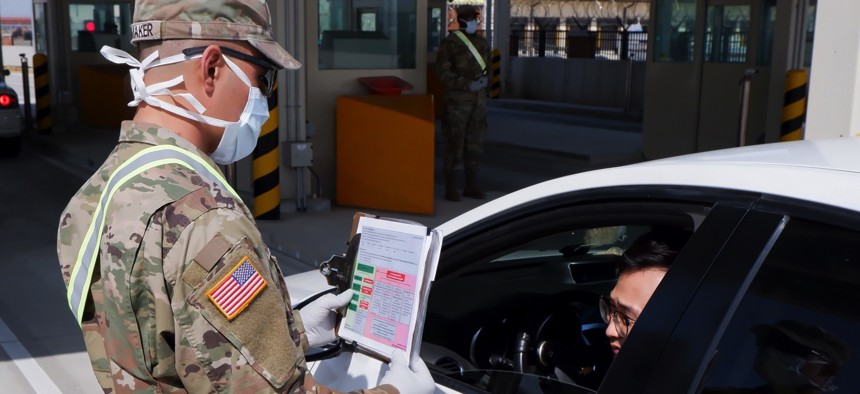
A soldier from the 2nd Armored Brigade Combat Team interviews a driver coming through the Adams Gate at U.S. Army Garrison-Humphreys, South Korea. U.S. Army / James Myer
US Army Wants Face Recognition at Base Gates
It's seeking a camera that can do the job through a rainy windshield at night.
The Army wants to make sure drivers entering bases through automated checkpoints are, in fact, who they claim to be, and is developing a new biometric camera system to assist.
The military branch issued a call on its Small Business Innovation Research, or SBIR, broad agency announcement—a contract vehicle used for working with small businesses on phased, iterative development programs—seeking early-stage design for a camera system able to pull usable images of drivers approaching checkpoints and matching those photos against a facial biometric database.
“The results would be displayed to the guard with a photo of the driver indicating an access granted or access denied response in time to allow uninterrupted vehicle traffic flow for approved users,” the call states.
For this specific use, the Army would compare the images taken by the camera with a preset gallery of approved entrants. This method threads the needle between one-to-one verification methods, which compare a new image with known photos of a person to verify their identity, and one-to-many identification algorithms, which compare an image to a broad database in search of the person’s identity.
This middle ground—used by other government agencies like Customs and Border Protection for their Entry/Exit facial recognition program—has a higher accuracy rate than one-to-many, so long as the environment allows for capture of a usable image.
For the Army’s automated checkpoints, this will be a significant factor.
The solution must be able to accurately capture a facial image through a windshield “in various weather conditions during the day and nighttime,” the call states.
The first phase will last six months, with a ceiling of $259,613 per proposal.
The second phase includes developing and demoing a prototype system on a government-built simulated checkpoint. By that point, the system must be able to identify passengers with a 100% success rate.
The third phase will focus on deploying the system at specific Army facilities.
The original BAA includes additional information about the various phases.
In a separate call on the same BAA, Army contracting officials asked for proposals to automate the cleaning of biometric data in the Defense Department’s Automated Biometric Identification System, or ABIS, the main biometric database used by the military.
“Much of this input is from old and nearing obsolescence, legacy collection systems that do not limit inputs that are incorrect or limit in any meaningful way based on image capture quality,” the second call states. “For this reason, the authoritative data base includes a large number of biometric records with errors, missing data or low-quality images.”
The DOD is embarking on a three- to five-year effort “to first, cleanse the data, and second, to continue to assess all incoming data, in order to rank and associate a data quality score for all images in the data base.”
The first phase of that program will focus on design concepts for machine-learning tools that can identify and rank the quality of data within ABIS. Future phases will focus on developing working prototypes and realigning existing systems to work with this new solution.
Questions for both calls are due by noon May 4. Proposals for both will be accepted through noon May 18.
